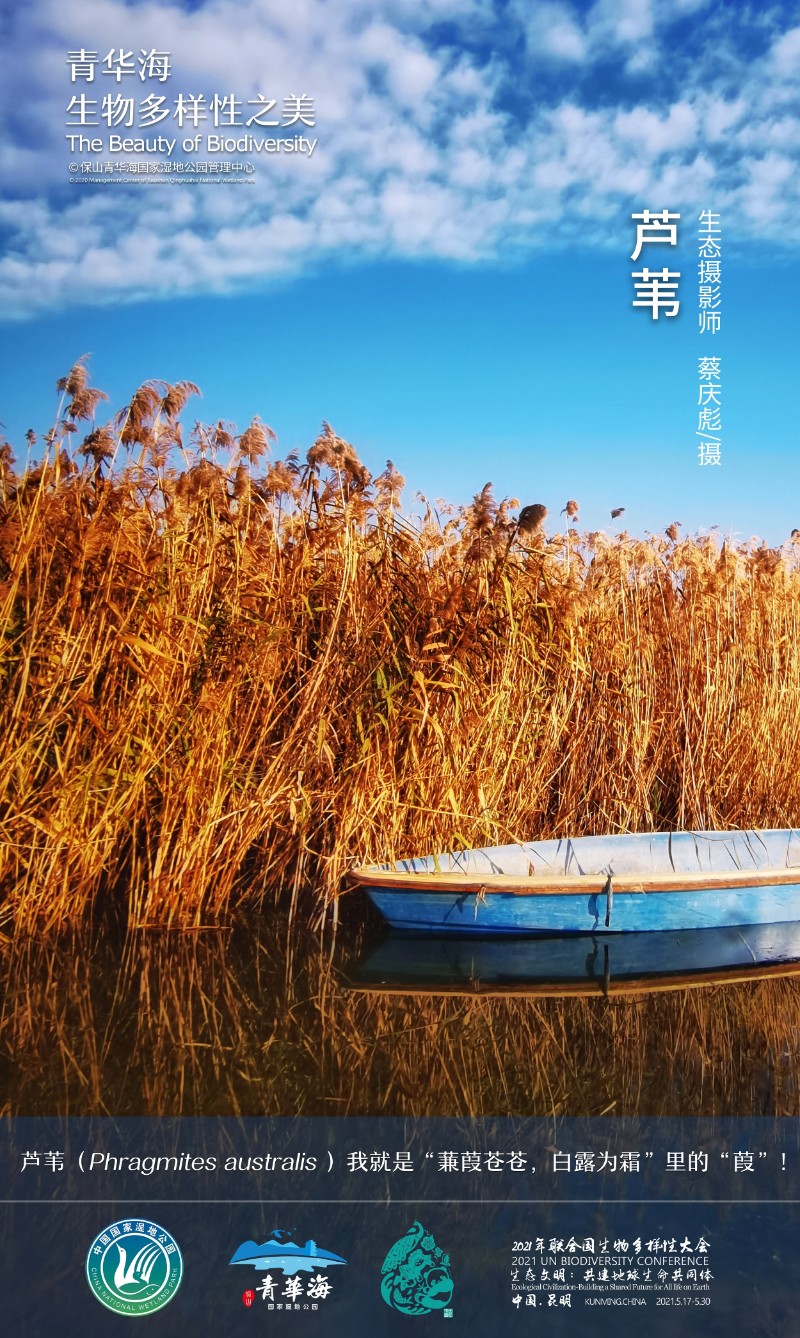【青華海生物多樣性之美】蘆葦:我就是“蒹葭蒼蒼,白露為霜”里的“葭”!

保山青華海國家濕地公園管理中心
保山市科學(xué)技術(shù)協(xié)會(huì)
聯(lián)合推出
第7期
The 7th Phase
被子植物.蘆葦Phragmites australis
被子植物門,禾本科,蘆葦屬。蘆葦分布廣泛,是多年生草本,生于水邊、沼澤地等濕生環(huán)境,是濕地生態(tài)系統(tǒng)的重要組成部分。“蒹葭(jiān jiā)蒼蒼,白露為霜。所謂伊人,在水一方。” 很多人以為《詩經(jīng).蒹葭》里的“蒹葭”指的就是蘆葦。實(shí)際上,“蒹葭”不是一種植物,而是兩種植物,這里面的葭指的是蘆葦,而蒹一般認(rèn)為是荻。圖片攝于云南保山青華海國家濕地公園。
蘆葦莖稈直立,植株高大,通常1-3米,迎風(fēng)搖曳,野趣橫生。它們的根和根狀莖生活在水下的淤泥里,另外能夠長出直立的地上莖,高高的挺出水面,是典型的挺水植物。這類植物的身體里通常都有很發(fā)達(dá)的通氣組織,比如蘆葦?shù)闹虚g是空心的,在看不見的地方還有很多的氣孔,方便它們位于水下的部分獲得空氣進(jìn)行呼吸。秋天,蘆葦開始變黃,植株的頂端形成大型的毛絨絨的穗子,白色的蘆花漫天飛揚(yáng),在微風(fēng)中輕輕搖曳,飄然如雪,成為濕地里一道美麗的風(fēng)景。這些穗,其實(shí)就是蘆葦?shù)墓麑?shí),飛舞的“蘆花”其實(shí)是它成熟的果實(shí)基部長出的絨毛。如果對(duì)著蘆花仔細(xì)尋找,就能在其中找到像沒脫殼的稻子一樣的果實(shí)(種子),這些白色絨毛是它們隨風(fēng)傳播的秘密武器。
蘆葦?shù)叵沦橘氲母鶢钋o十分發(fā)達(dá),繁殖能力和適應(yīng)性強(qiáng),能夠迅速擴(kuò)展領(lǐng)地,所以我們總能看到大片的蘆葦。大面積蘆葦能調(diào)節(jié)氣候,涵養(yǎng)水源,形成良好濕地生境,是鳥類棲息、覓食、繁殖家園。夏天,噪大葦鶯在蘆葦叢中筑巢、高歌,“呱呱呱唧”的叫聲熱鬧了整個(gè)夏天。黑水雞、黃葦鳽以蘆葦為掩護(hù)筑巢育雛。秋天,蘆葦種子為斑文鳥和麻雀提供了可口的食物。它們小小的身軀在細(xì)細(xì)的蘆葦桿上下?lián)u晃,嘴里塞滿了毛茸茸的種子。
蘆葦不僅能為其他生物提供良好的生存環(huán)境,其在生長過程中還可以吸收水中氮、磷等營養(yǎng)元素,對(duì)有機(jī)物和重金屬也有較強(qiáng)的富集和去除作用,達(dá)到凈化水體的效果。另外,蘆葦能夠固碳,防止水土流失、固土護(hù)坡,還具有抵御外來入侵植物的潛力。同時(shí),蘆葦?shù)亩捒梢杂脕碓旒垼ㄓ捎跁?huì)產(chǎn)生污染,現(xiàn)在用得較少)、做建筑材料、制作蘆笛、編織葦席和葦簾,蘆葉可以用來包粽子,花絮可以做枕頭填充物。另外,蘆葦還可以用來制作美麗的蘆葦畫。其根、莖、葉還具有一定的藥用功能。
到了吃貨最關(guān)心的問題,蘆葦可以吃嗎?其實(shí),它身上還是有可以吃的部分的。比如它的嫩芽是可以當(dāng)蔬菜來吃的。宋朝的沈括在《夢(mèng)溪補(bǔ)筆談》曾寫到“蘆芽味稍甜,作蔬尤美”。我國著名的吃貨文學(xué)家蘇軾也曾寫過“蔞蒿滿地蘆芽短,正是河豚欲上時(shí)”這樣的句子。又比如蘆葦?shù)母鶢钋o,稱為“蘆根”,里面會(huì)積累一些糖分,主要用于食療,據(jù)說有清熱瀉火,生津利尿的功效。但是要把蘆葦埋在地下的莖挖出來實(shí)在是有些費(fèi)勁。
為了維護(hù)水生態(tài)系統(tǒng)的健康,需要應(yīng)季及時(shí)收割蘆葦。因?yàn)椋笃煽莸奶J葦不僅有消防隱患,而且它們水體污染物的吸附能力已經(jīng)達(dá)到飽和,如果讓大量的蘆葦殘?bào)w在水中腐爛的話,還會(huì)嚴(yán)重影響水質(zhì),破壞水生態(tài)環(huán)境。去除蘆葦枯萎、死亡的地上部分,不僅有利于改善蘆葦?shù)纳L狀況,還可恢復(fù)其吸附水體污染物的功能。但要注意的是,收割蘆葦?shù)人莸墓ぷ饕荛_鳥類繁殖期,為它們留下繁殖的空間。
The 7th Phase
Common Reed(Phragmites australis)
Angiospermae, Gramineae, Phragmites. Common Reed is widely distributed and a perennial herb, which is grow in wet environment such as waterside and marsh. It is an important part of wetland ecosystem. “Green, green the jianjia, Dew and frost gleam. Where’s she I need? Beyond the stream.” Many people think that “jianjia” from this song of The Book of Songs is the Common Reed. In fact, they are two different plants. “jia” here refers to the Common Reed, while the “jian” is generally considered as Miscanthus sacchariflorus. The photo is taken in The Qinghuahai National Wetland Park in Baoshan city, Yunnan proince.
The stems of the Common Reed stand uprightly and is tall usually about 1-3 meters, swinging with wind, facinating and interesting. Their roots and rhizomata live in the mud under the water, and they are typical emerging plants, and capable to grow uprightly above-ground stems above the water. These plants usually have well-developed ventilating tissues in their bodies. For example, the Common Reed is hollow in the middle, and have many pores that cannot be seen, so that their underwater parts can get air to breathe. In autumn, the Common Reed begin to turn yellow, and the top of the plants form large fluffy ears. The white Common Reed flowers fly all over the sky, swinging gently, which looks like snow, becoming a beautiful scenery of wetland. These ears, in fact, are the fruits of the Common Reed, the flower, is actually its villous mature fruit. If you look closely at the “flowers”, you'll find fruit (seeds) like unshelled rice. These white villous are their secret weapon to spread by wind.
The underground creeping rhizomes of the Common Reed is well developed, with good reproduction and adaptability. They are capable to expend their territory rapidly, so that we can always see large reed marshes. Large area of Common Reed can regulate the climate, conserve water and form a good wetland habitat, which is the home of birds living, foraging and breeding. In summer, the Clamorous Reed Warbler nest in the reeds and sing loudly, whose songs hum the summer. Common Moorhen and Yellow Bittern nesting under the guise of reeds. In autumn, Common Reed seeds provide delicious food for Scaly-breasted Munia and Eurasian Tree Sparrow. Their tiny bodies swing up and down thin Common Reed stalks, with mouths stuffed with fluffy seeds.
Common Reed can not only provide a good living environment for other organisms, but also absorb nitrogen, phosphorus and other nutrient elements in the water during the growth. It also has a strong enrichment and removal effect on organic matters and heavy metals, so they can purify the water. In addition, the Common Reed can fixed carbon, prevent soil erosion, soil and slope protection, they also has the potential to resist alien invasive plants. The stalks of Common Reed can be used to make paper (less now because of pollution), make reed flutes, weave reed mats and reed curtains, and also as building materials. Common Reed leaves can be used to make zongzi and inflorescence to fill pillow. In addition, reeds can be used to make beautiful reed paintings. Its root, stem, leaf also has some kind of medicinal function.
When it comes to the foodie's greatest concern, can Common Reed be eaten? In fact, it still has edible parts. For example, its tender bud can be eaten as vegetables. Shen Kuo in the Song Dynasty wrote in his book " The tender bud of Common Reed taste slightly sweet and it's especially good as a vegetable". Su Shi, one of China's most famous foodie writers, wrote that " Artemisia selengensis are everywhere and the tender bud of Common Reed are green and short, which is the time that puffer is about to swim back into river from sea." Moreover, the rhizome of Common Reed, called "reed root", will accumulate some sugar, which is mainly used for food therapy. It is said to have the function of clearing away heat and toxic materials, promoting fluid production and diuresis. But it was difficult to dig out the stalks of the reeds buried in the ground.
In order to maintain the health of the aquatic ecosystem, Common Reed should be harvested timely and seasonally. This is because large areas of dried reed not only have fire hazards, but also their adsorption capacity of water pollutants has reached saturation. If a large number of reed residues are left and rot in the water, the quality of water will be seriously affected and water ecological environment will be destroyed. Removing the withered and dead overground part of reed is not only beneficial to improve the growth condition of reed, but also can restore its function of absorbing water pollutants. But it should be noted that the harvesting of reeds and other aquatic plants should avoid the breeding period of birds and leave places to breed.
今天是2021年第一天,新年快樂!
攝影師介紹
Introduction of the photographer

蔡慶彪,1989年生,貴州人 。2008年離開貴州到云南保山接觸攝影。保山市攝影協(xié)會(huì)會(huì)員,隆陽區(qū)攝影協(xié)會(huì)常務(wù)理事,中國民俗攝影協(xié)會(huì)會(huì)員。多幅作品在攝影比賽中獲獎(jiǎng),在各類攝影展中展示并被入冊(cè)出版。長期在青華海拍鳥,其鳥類作品曾多次獲獎(jiǎng),《水雉的故事》曾獲青華海鳥類攝影大賽視頻組金獎(jiǎng),并登上央視,同時(shí)也是東方鸻、玉帶海雕等云南和保山鳥類新記錄的記錄者。
Qingbiao Cai, born in 1989, Guizhou native and left Guizhou for Baoshan In 2008. From then on, he began to learn photography. He is a member of Baoshan Photography Association and China Folk Photography Association, and the executive director of Longyang District Photography Association. Many of his works have won awards in photography competitions, and be exhibited and published. He has been taking photos of birds in The Qinghuahai for a long time, and his bird works have won many awards. The Story of Pheasant-tailed Jacana won the gold medal in the Video group of the Qinghuahai Bird Photography Contest and was listed on CCTV. Moreover, he is also the recorder of the Oriental Plover and Pallas's Fish Eagle, which are the new records of Yunnan and Baoshan birds.
文字整理:黃木嬌
海報(bào)設(shè)計(jì):黃木嬌
英文翻譯:何雪、黃木嬌
Text: Mujiao Huang
Poster design: Mujiao Huang
English translation: He Xue, Mujiao Huang
| 版權(quán)聲明: 1.依據(jù)《服務(wù)條款》,本網(wǎng)頁發(fā)布的原創(chuàng)作品,版權(quán)歸發(fā)布者(即注冊(cè)用戶)所有;本網(wǎng)頁發(fā)布的轉(zhuǎn)載作品,由發(fā)布者按照互聯(lián)網(wǎng)精神進(jìn)行分享,遵守相關(guān)法律法規(guī),無商業(yè)獲利行為,無版權(quán)糾紛。 2.本網(wǎng)頁是第三方信息存儲(chǔ)空間,阿酷公司是網(wǎng)絡(luò)服務(wù)提供者,服務(wù)對(duì)象為注冊(cè)用戶。該項(xiàng)服務(wù)免費(fèi),阿酷公司不向注冊(cè)用戶收取任何費(fèi)用。 名稱:阿酷(北京)科技發(fā)展有限公司 聯(lián)系人:李女士,QQ468780427 網(wǎng)絡(luò)地址:www.arkoo.com 3.本網(wǎng)頁參與各方的所有行為,完全遵守《信息網(wǎng)絡(luò)傳播權(quán)保護(hù)條例》。如有侵權(quán)行為,請(qǐng)權(quán)利人通知阿酷公司,阿酷公司將根據(jù)本條例第二十二條規(guī)定刪除侵權(quán)作品。 |
 m.quanpro.cn
m.quanpro.cn